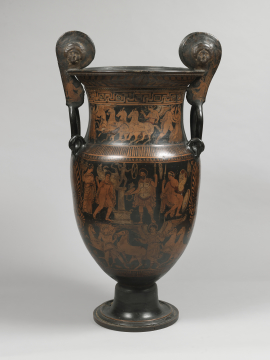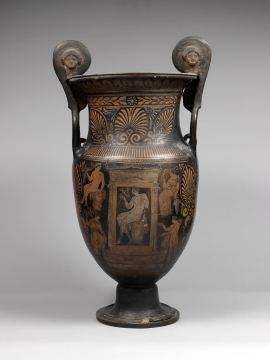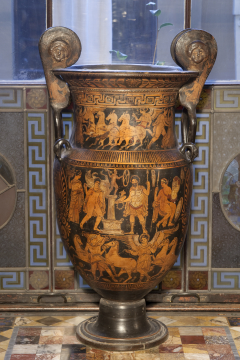Explore Collections


You are here:
CollectionsOnline
/
An Apulian (Greek) Mascaroon krater known as the 'Cawdor Vase'
Browse
An Apulian (Greek) Mascaroon krater known as the 'Cawdor Vase'
Late 4th century BC
Apulian
Apulian
Apulia
A Greek provincial vase made in a Greek colony in southern Italy.
A Greek provincial vase made in a Greek colony in southern Italy.
Height (including handles): 92cm, maximum
Height (excluding handles): 80cm
Diameter (including handles): 48cm, maximum
Diameter (at mouth): 42cm, maximum
Circumference (excluding handles): 136cm, maximum
Height (excluding handles): 80cm
Diameter (including handles): 48cm, maximum
Diameter (at mouth): 42cm, maximum
Circumference (excluding handles): 136cm, maximum
Museum number: L101
On display: Library-Dining Room
All spaces are in No. 13 Lincoln's Inn Fields unless identified as in No. 12, Soane's first house.
For tours https://www.soane.org/your-visit
Curatorial note
The first two images show sides A and B. The third (colour) image shows the vase on display in Sir John Soane's Museum.
Side A
The neck: A nude Nike drives a quadriga preceded by another, fully clad Nike to the left. At the right a Dionscuros seizes one of the daughters of Leucippos. Above: The sacrifice by Oinomaos prior to his chariot race with Pelops. The king stands at the altar of Zeus, holding a phiále, a wreath and a flower in his right hand, a spear vertically in the left, while a youth (Myrtilos?) brings up a ram for sacrifice. On the right of this group sits a retainer with armour about; from the left a female figure wearing diadem, ear-ring, and necklace approaches with a basket, a fillet, and three epichýseis. The altar is horned, and above it rises a pillar with moulded top, on which the Zeus image stands advancing and brandishing a thunderbolt. The object behind his left hand must be understood as a spare wheel for Oinomaos' chariot, like the armour also suspended in the nearby field.
Below: A winged female figure nimbate and in short chiton stands holding the reins of two unharnessed horses at the right and shares the two at the left with an attendant in chalmys (chlamys?) and boots standing between them.
Side B
The neck: three large palmettes.
Above and below: A nude male figure seated on a cuirass in a large, columned aedicula, flanked on the left by a nude youth seated on a cuirass (above) and a standing draped female (below), on the right by a seated female (above), and a nude youth below (all somewhat retouched).
The decoration features large, elaborate palmettes beneath the handles, and from top to bottom laurel, meander, thin dentils, ovolo (on side A) and wave (on side B), and filleted meander as the base groundline.
This vase belongs to the late, post-Darian group and is characterized by the rather hideous drawing of the faces. There is a large krater by the same hand in Naples and from the fame of the Soane example we may be perfectly justified in calling the artist the Cawdor Painter.
Side A
The neck: A nude Nike drives a quadriga preceded by another, fully clad Nike to the left. At the right a Dionscuros seizes one of the daughters of Leucippos. Above: The sacrifice by Oinomaos prior to his chariot race with Pelops. The king stands at the altar of Zeus, holding a phiále, a wreath and a flower in his right hand, a spear vertically in the left, while a youth (Myrtilos?) brings up a ram for sacrifice. On the right of this group sits a retainer with armour about; from the left a female figure wearing diadem, ear-ring, and necklace approaches with a basket, a fillet, and three epichýseis. The altar is horned, and above it rises a pillar with moulded top, on which the Zeus image stands advancing and brandishing a thunderbolt. The object behind his left hand must be understood as a spare wheel for Oinomaos' chariot, like the armour also suspended in the nearby field.
Below: A winged female figure nimbate and in short chiton stands holding the reins of two unharnessed horses at the right and shares the two at the left with an attendant in chalmys (chlamys?) and boots standing between them.
Side B
The neck: three large palmettes.
Above and below: A nude male figure seated on a cuirass in a large, columned aedicula, flanked on the left by a nude youth seated on a cuirass (above) and a standing draped female (below), on the right by a seated female (above), and a nude youth below (all somewhat retouched).
The decoration features large, elaborate palmettes beneath the handles, and from top to bottom laurel, meander, thin dentils, ovolo (on side A) and wave (on side B), and filleted meander as the base groundline.
This vase belongs to the late, post-Darian group and is characterized by the rather hideous drawing of the faces. There is a large krater by the same hand in Naples and from the fame of the Soane example we may be perfectly justified in calling the artist the Cawdor Painter.
The Cawdor Vase is said erroneously by Michaelis to have been found in 1790 near Lecce in Southern Italy; then in the possession of the King of Naples, then purchased by General Oudinot, sent to England, and sold for 1000 guineas to Baron Cawdor (d.1821). Michaelis erroneously states (pp.163 and 481) that at the sale of the collection of J. Edwards, the bookseller in Pall Mall, this vase came into Soane’s possession. This is not the case. The royal provenance quoted by Michaelis is incorrect and attaches to the vase sold by Edwards now in the Metropolitan Museum, New York (accession no. 56.171.63) and not to the vase in Soane's collection.
An entry in Soane’s Journal 1 dated 9 May 1800 reads “Paid Mr. Taylor for vases bought at Lord Cawdor’s Sale” and contains an individual item £68.5.0, which is this vase. The auction was by Messrs Skinner and Dyke on 5 and 6 June 5 1800. A rare marked-up copy of the Cawdor Sale Catalogue records 'Soane' as the purchaser of Lot 64, A magnificent vase of the largest size that has yet been discovered; was formerly companion to one of the same dimensions in the Vatican Museum; the Enrichments on this Vase are numerous and varied: the principal subject is a Sacrifice to JUPITER TONANS [sic], and from the excellence of the whole it is presumable that this vase was placed originally as an ex voto in a temple dedicated to that Deity. The catalogue records the price as noted in Soane's Journal, £68.5.0.
Literature
J.B. Passeri, Picturae Etruscorum in Vasculis, Rome, 1775, III, pl.282ff.
H. Moses, A Collection of Vases ... London, 1814, pl.23.
J. Britton, The Union of Architecture, Sculpture, and Painting ... London, 1827, p.51, Title-page fig. 1, 6.
T. Panofka, in the Abhandlungen der berliner akademie, 1853, Phil-hist. Classe, pls. 1,2, no.5.
Adolf Michaelis, Ancient Marbles in Great Britain, trans. C.A.M. Fennell, Cambridge, 1882, Introduction, pp. 93, 94, note 248, p.153, n. 439, p. 481, no.38, (cites Description, 1876, p.5 fig.).
L. Stephani in the Compte-rendu St. Pet., 1863, p.268, n.1; 1868, p.169.
A. Conze in the Arch. Zeitung, 1864, XXII, Anz. P.165.
Johannes Overbeck, Griechische Kunstmythologie, 3 volumes, Leipzig 1871/89: Zeus pp.6, 208f., 602.
A.B. Cook, Zeus, Cambridge, 1914-40, vol. I, p.39, pl.V.
Description of Sir John Soane's Museum, 1930, p.34, fig. 13.
Maria Emilia Masci, 'Il Vaso Cawdor: da Napoli a Londra, Appunti sul collezionismo Napoletano all 'epoca del Grand Tour', Napoli Nobilissima, Rivista di Arti, Filologia e Storia, Quinta serie, Vol.III, Fascicoli I-II - Gennaio, April 2002
Dr Ian Jenkins, 'The past as a foreign country: Thomas Hope's collection of antiquities' in Thomas Hope Regency Designer (ed. David Watkin and Philip Hewat-Jaboor), 2008, p.124
Tyler Jo Smith, “Myth, Cult and Performance: Sir John Soane’s Cawdor Vase”, Bulletin of the Institute of Classical Studies 57 (2014), pp.96-123.
H. Moses, A Collection of Vases ... London, 1814, pl.23.
J. Britton, The Union of Architecture, Sculpture, and Painting ... London, 1827, p.51, Title-page fig. 1, 6.
T. Panofka, in the Abhandlungen der berliner akademie, 1853, Phil-hist. Classe, pls. 1,2, no.5.
Adolf Michaelis, Ancient Marbles in Great Britain, trans. C.A.M. Fennell, Cambridge, 1882, Introduction, pp. 93, 94, note 248, p.153, n. 439, p. 481, no.38, (cites Description, 1876, p.5 fig.).
L. Stephani in the Compte-rendu St. Pet., 1863, p.268, n.1; 1868, p.169.
A. Conze in the Arch. Zeitung, 1864, XXII, Anz. P.165.
Johannes Overbeck, Griechische Kunstmythologie, 3 volumes, Leipzig 1871/89: Zeus pp.6, 208f., 602.
A.B. Cook, Zeus, Cambridge, 1914-40, vol. I, p.39, pl.V.
Description of Sir John Soane's Museum, 1930, p.34, fig. 13.
Maria Emilia Masci, 'Il Vaso Cawdor: da Napoli a Londra, Appunti sul collezionismo Napoletano all 'epoca del Grand Tour', Napoli Nobilissima, Rivista di Arti, Filologia e Storia, Quinta serie, Vol.III, Fascicoli I-II - Gennaio, April 2002
Dr Ian Jenkins, 'The past as a foreign country: Thomas Hope's collection of antiquities' in Thomas Hope Regency Designer (ed. David Watkin and Philip Hewat-Jaboor), 2008, p.124
Tyler Jo Smith, “Myth, Cult and Performance: Sir John Soane’s Cawdor Vase”, Bulletin of the Institute of Classical Studies 57 (2014), pp.96-123.
Soane collections online is being continually updated. If you wish to find out more or if you have any further information about this object please contact us: worksofart@soane.org.uk







